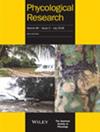共生甲藻Zooxanthella(Brandtodinium)营养菌的半乳糖脂质、甜菜碱脂质和甘油三酯相关脂肪酸的组成:对其多胱氨酸放射虫宿主可用的多不饱和脂肪酸的一瞥
IF 1
4区 生物学
Q2 MARINE & FRESHWATER BIOLOGY
引用次数: 0
摘要
营养Zooxanthella nutricula是多胱氨酸放射虫的光合甲藻共生体。因此,假设它向其非光合宿主提供固定的有机碳,包括酰基甘油酯和甾醇的形式。我们之前已经对营养Z.nutricula的甾醇进行了表征,这些甾醇可能会转移到宿主身上,在本研究中,我们将注意力转向了三类含脂肪酸的脂质、叶绿体相关的半乳糖脂质、甜菜碱脂质和甘油三酯,甜菜碱脂质是许多真核生物中存在的非磷酸化磷脂类似物。使用正离子电喷雾/质谱法(ESI/MS)和ESI/MS/MS观察营养虫黄藻,以产生富含十八碳五烯酸(18:5(n-3))和十八碳四烯酸(18:4(n-3(sn‐1/sn‐2脂肪酸区域化学)簇,而不是另一个具有C20/C18 MGDG和DGDG的簇,其中C20脂肪酸是二十碳五烯酸(20:5(n-3)),C18脂肪酸是18:5(n-2)或18:4(n-3。还观察到营养Zooxanthella nutricula产生38:10(脂肪酸碳的总数:双键的总数)、38:6和44:7二酰基甘油羧基羟甲基胆碱(DGCC)作为唯一类型的甜菜碱脂质。尽管使用ESI/MS/MS更难确定DGCC甘油主链上的sn-1和sn-2位置存在哪些脂肪酸,但基于气相色谱/质谱(GC/MS)的检查表明,推定的DGCC相关多不饱和脂肪酸(PUFA)二十二碳六烯酸(22:6(n-3))。再加上MGDG和DGDG的C18 PUFA,以及与甘油三酯相关的脂肪酸(也通过GC/MS检测),营养Z.nutricula可以作为其放射虫宿主的丰富PUFA来源。这些数据表明,营养Z.nutricula产生的一组含有PUFA的脂质与微driaticum共生体相似,微driatic共生体是线虫的一种光合甲藻共生体,这表明这些系统发育上离散的甲藻共生物与不相关的宿主生物具有代谢共性。本文章由计算机程序翻译,如有差异,请以英文原文为准。
Composition of galactolipids, betaine lipids and triglyceride‐associated fatty acids of the symbiotic dinoflagellate Zooxanthella (Brandtodinium) nutricula: A glimpse into polyunsaturated fatty acids available to its polycystine radiolarian host
Zooxanthella nutricula is a photosynthetic dinoflagellate symbiont of polycystine radiolarians. As such, it is hypothesized to provide fixed organic carbon, including in the form of acylglycerolipids and sterols, to its non‐photosynthetic host. We have previously characterized the sterols of Z. nutricula that may be transferred to its host and, in the present study, have turned our attention to three classes of fatty acid‐containing lipids, chloroplast‐associated galactolipids, betaine lipids, which are non‐phosphorylated phospholipid analogs present in many eukaryotes, and triglycerides. Zooxanthella nutricula was observed using positive‐ion electrospray/mass spectrometry (ESI/MS) and ESI/MS/MS to produce the galactolipids mono‐ and digalactosyldiacylglycerol (MGDG and DGDG, respectively) enriched in octadecapentaenoic (18:5(n‐3)) and octadecatetraenoic (18:4(n‐3)) acid to place it within a group of peridinin‐containing dinoflagellates in a C18/C18 (sn‐1/sn‐2 fatty acid regiochemistry) cluster, as opposed to another cluster with C20/C18 MGDG and DGDG, where the C20 fatty acid is eicosapentaenoic acid (20:5(n‐3)) and the C18 fatty acid is either 18:5(n‐3) or 18:4(n‐3). Zooxanthella nutricula was also observed to produce 38:10 (total number of fatty acid carbons:total number of double bonds), 38:6, and 44:7 diacylglycerylcarboxyhydroxymethylcholine (DGCC) as the sole type of betaine lipid. Although it is more difficult to determine which fatty acids are present in the sn‐1 and sn‐2 positions on the glycerol backbone of DGCC using ESI/MS/MS, gas chromatography/mass spectrometry (GC/MS)‐based examination indicated the putatively DGCC‐associated polyunsaturated fatty acid (PUFA) docosahexaenoic acid (22:6(n‐3)). Coupled with the C18 PUFAs of MGDG and DGDG, and fatty acids associated with triglycerides (also examined via GC/MS), Z. nutricula could serve as a rich source of PUFAs for its radiolarian host. These data demonstrate that Z. nutricula produces a similar set of PUFA‐containing lipids as Symbiodinium microadriaticum, a photosynthetic dinoflagellate symbiont of cnidarians, indicating a metabolic commonality in these phylogenetically discrete dinoflagellate symbionts with unrelated host organisms.
求助全文
通过发布文献求助,成功后即可免费获取论文全文。
去求助
来源期刊

Phycological Research
生物-海洋与淡水生物学
CiteScore
3.60
自引率
13.30%
发文量
33
审稿时长
>12 weeks
期刊介绍:
Phycological Research is published by the Japanese Society of Phycology and complements the Japanese Journal of Phycology. The Journal publishes international, basic or applied, peer-reviewed research dealing with all aspects of phycology including ecology, taxonomy and phylogeny, evolution, genetics, molecular biology, biochemistry, cell biology, morphology, physiology, new techniques to facilitate the international exchange of results. All articles are peer-reviewed by at least two researchers expert in the filed of the submitted paper. Phycological Research has been credited by the International Association for Plant Taxonomy for the purpose of registration of new non-vascular plant names (including fossils).
 求助内容:
求助内容: 应助结果提醒方式:
应助结果提醒方式:


